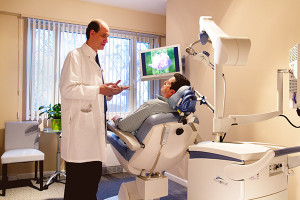TMS Compared to ECT
- Home
- TMS Compared to ECT
- Physical Effects – Motor skills are compromised for a time and patients should not drive or work during a course of ECT.
- Memory Loss – ECT patients often experience memory loss, and there is the possibility of long-term memory damge.
- Physical Harm – As ECT is an induced seizure, patients must be sedated during treatment, and without careful handling and monitoring, there is the potential for self-inflicted damage.
TMS Compared to ECT
This clinical paper article (written out below) reviews the doctors’ comparison of TMS and ECT, and it goes into more detail on the differences between the two treatments.
Introduction
Electroconvulsive therapy (ECT), formerly known as electroshock, is a psychiatric treatment in which seizures are electrically induced in anesthetized patients for therapeutic effect. Its mode of action is unknown. Today, ECT is most often recommended for use as a treatment for severe depression that has not responded to other treatment, and is also used in the treatment of mania and catatonia and acute suicidality.
Transcranial Magnetic Stimulation (TMS) is a simple treatment that uses focused MRI- type pulsed magnetic fields to create a small electrical current in precise areas of the brain known to be involved in causing the symptoms of depression.

Comparison of Treatments
Safety
There is no question that ECT is more burdensome and potentially more dangerous than TMS. ECT, as its name implies involves a seizure with associated hemodynamic effects namely increases in blood pressure and pulse which may stress an abnormal heart.
Careful attention has to be paid to muscle relaxation to avoid fractures from the intense muscle contractions occurring during a seizure, which have the potential to cause fractures. It requires general anesthesia with the associated dangers and side effects. Upon awakening the patient is often confused. For these reasons ECT is often given as an inpatient procedure and if given as an outpatient procedure a family member must drive the patient home.
Therapy Procedure
Generally during a course of ECT, which is 6-12 treatments given at the rate of 2-3 per week the patient, cannot work or drive. Important personal decisions should not be made during or immediately after a course of ECT. Memory is severely affected and some memory loss may be irreversible.
- None of the above ECT safety concerns apply to TMS.
Patients walk in, get their treatments and go about their business. There are no cognitive adverse effects. There may often be an improvement in cognition independent of changes in depression. No memory loss occurs and no anesthesia is given.
However TMS usually requires treatments 5 days per week for 3 to 6 weeks. While ECT Is a more expensive procedure it is more frequently covered by insurance, TMS is less expensive but requires coverage to be secured typically on a case-by-case basis.
Efficacy
The relative efficacy of this two-treatment technique is a point of contention. While ECT is usually reported to have a 60-70% remission rate the often-cited studies of TMS including the pivotal study leading to FDA approval have a considerably lower rate. On the other hand these studies did not allow concomitant medication or adjustment of TMS parameters. In our hands medications are usually given together with TMS, and parameters of TMS are individualized. Under these conditions the results of TMS treatment are comparable to those of ECT.
Head to head comparisons have shown mixed results with both superiority of ECT and equivalence of the two procedures being reported. It is generally considered true that ECT is superior for the treatment of patients with psychotic depression. There has been some speculation that TMS may be useful for maintenance therapy of ECT treated patients. Results following ECT are generally poor when medications are used for maintenance.
As practicing psychiatrists we see a place for ECT when suicidality, malnutrition psychotic depression or catatonia is present or when TMS has been tried. Otherwise we recommend that our patients try TMS due to its significantly lower procedure risk, convenience and indications that its efficacy may be comparable to that of ECT.
